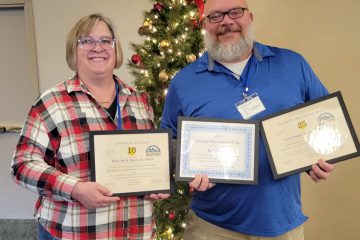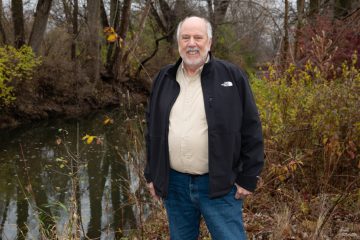Illinois lawmakers are arguing the USDA isn’t allocating enough federal funds for our state, given it ranks fourth in the nation in planted cropland, and asks for doubling or tripling the support for healthy soils and cleaner water.
“We are writing to express our concerns that Illinois, one of the top states in the nation for agriculture planted acres, receives a disproportionate share of funds . . . for critical farm conservation incentives. We request that USDA double, even triple, the percentage of nationwide conservation funding allocated to Illinois. We also urge USDA to revise its program rules to better recognize the conditions specific to Illinois agriculture so that participation in these critical farm conservation programs can be rapidly expanded in our state.”
Illinois’ 97 local Soil & Water Conservation Districts stand ready to help farmers and landowners bring more EQIP, Inflation Reduction Act, and other federal grants to Illinois.
“Well-funded, locally-led Soil and Water Conservation Districts are the vital linchpin to ensure that any and all federal conservation funds secured for Illinois are put on the ground across all 102 Counties” said Michael Woods, Executive Director of the Association of Illinois Soil and Water Conservation Districts. “Building on the historically strong relationship between the Natural Resources Conservation Service and the state’s 97 SWCDs, the statewide SWCD team of conservation professionals hear the Illinois Congressional Coalition’s call and are ready to stand arm-and-arm to put these vital funds to work protecting the state’s most vital natural resources…soil and water.”
The letter was signed by Senators Dick Durbin and Tammy Duckworth
House Agriculture Committee members
Nikki Budzinski
Eric Sorensen
Jonathan Jackson
And House members
Danny K. Davis
Sean Casten
Mike Quigley
Delia C. Ramirez
Raja Krishnamoorthi
Bill Foster
Robin L. Kelly
Lauren Underwood
See the full text of the letter online and pasted in below:
Dear Secretary Vilsack:
We are writing to express our concerns that Illinois, one of the top states in the nation for agriculture planted acres, receives a disproportionate share of funds from the United States Department of Agriculture (USDA) Natural Resources Conservation Service (NRCS) for critical farm conservation incentives. We request that USDA double, even triple, the percentage of nationwide conservation funding allocated to Illinois. We also urge USDA to revise its program rules to better recognize the conditions specific to Illinois agriculture so that participation in these critical farm conservation programs can be rapidly expanded in our state.
Illinois ranks fourth in the nation in planted cropland, but from 2018 to 2022, Illinois ranked just 37th nationally in funds sent by USDA for the Environmental Quality Incentives Program (EQIP), a program that provides incentives to help farmers adopt cover crops, conservation tillage, and other critical environmental practices. The Inflation Reduction Act (IRA) added $20 billion to USDA NRCS conservation programs. Of the first $2 billion installment USDA distributed nationwide, Illinois was provided only $48 million, or two percent. Texas, with a similar amount of planted cropland to Illinois, was provided $166 million in conservation funds—nearly eight percent of the national total and nearly four times more than Illinois—for projects that some groups have criticized as negligible for addressing climate change.
USDA NRCS also sends a larger percentage of national conservation dollars to Illinois’ neighboring farm states. Some in Congress are seeking to double federal payments in the Farm Bill to the one percent of southern farmers who historically have grown cotton, rice, and peanuts; USDA NRCS sends a larger percentage of conservation dollars to those states, too, which have two-to three-times fewer planted acres of crops compared to Illinois.
Illinois faces pressing agricultural environmental issues. Illinois increasingly experiences severe dust storms during planting season. In 2023, eight people tragically lost their lives in a violent 84-car pileup on Interstate 55 caused by a major dust storm. This year, at least three hazardous dust storms have closed major interstates in Illinois after causing dangerous visibility conditions for drivers. Also, since 2015, Illinois has worked to reduce fertilizer runoff into waterways that cause hypoxia, or the “dead zone,” in the Gulf of Mexico. Illinois and Iowa are the two top contributors (15 percent each) to nitrogen runoff in these waterways. Illinois published a progress report last year that concluded, once again, the state will miss its runoff reduction goals.
Moreover, farmers in Illinois also are working to adjust to policies that now require climate-smart farming for eligibility. New programs such as the Low Carbon Fuels Standard requirements in California, Oregon, and Washington, and the carbon-reduction designs of the new Sustainable Aviation Fuel federal tax credit require farmers to dramatically expand the adoption of climate-smart practices to be eligible for participation, like cover crops, conservation tillage, and fertilizer reduction. Better access to USDA’s conservation funding would assist in these efforts.
In addition, USDA must rethink how these conservation programs are administered, because the current one-size-fits-all approach creates challenges in Illinois. Illinois farms have a tremendous diversity of terrain, soils, moisture, microclimates, weather patterns, and cropping practices. USDA, however, requires all farms, regardless of location, to adopt uniform, inflexible “standards” to be eligible for reimbursement for adopting these conservation practices, such as blanket instructions on total density of cover crop seeds to be planted per acre; or whether a seed can only be planted by drones, drilling, or broadcasting, and when.
The cost of cover crops adds up quickly for seed, fuel, labor, removal, and time, and cover crops often cannot be sold to recover those costs. Farmers must test the right cover crops that do not interfere with crop insurance, yields, or tight planting windows for corn or soybeans. Couple these challenging dynamics with USDA’s low funding allocations to Illinois, cumbersome program rules, federal staffing shortages, and application processing backlogs, and many Illinois farmers are discouraged from applying for these USDA incentives altogether—and if they do, one estimate says 40 percent of valid Illinois applications go unfunded by USDA.
While more farmers are adopting conservation practices, there is a long way to go: of the 22 million acres of cropland in Illinois, cover crops are planted on fewer than one million acres, and conservation tillage and fertilizer approaches are on about eight million acres. Congress provided USDA with an extraordinary investment in farm conservation funds due to the urgency of climate change, dust storms, and runoff. USDA must boost the percentage of conservation funds sent to Illinois to match our status as a top farming state. USDA also must simplify its rules to accommodate Illinois farmers and place greater emphasis on achieving environmental results in a swift timeframe: millions of new acres of cover crops, conservation tillage, and fertilizer reduction practices installed in Illinois, in the next few years.
We look forward to working with you to achieve these improvements and thank you for your attention to this important issue.


